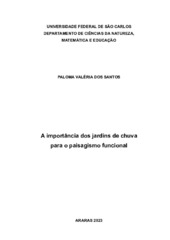A importância dos jardins de chuva para o paisagismo funcional
Abstract
This study analyzed the use of plant species present in 20 rain gardens located in the municipality of São Paulo, evaluating the contribution of the plants used for functional landscaping. Firstly, a bibliographic survey was carried out on the existence or not of criteria that should be considered when choosing appropriate species for this type of infrastructure, where the criteria found were described and referenced. Subsequently, the species already used were surveyed through images, maps, and videos, where the initial identification was done through Google Lens®, followed by confirmation of genus and species, using specialized books and institutions in botany, such as Lorenzi (2021, 2022); the Flora do Brasil (JBRJ) platform - from the Rio De Janeiro Botanical Garden and the Plants of the World Online platform, Kew, UK, which are specialized in Botanical Systematics. The plants found were analyzed for their profile for functional landscaping, checking if they were native or exotic species from Brazil, as well as if they were native to the region where the rain garden was located. Additionally, they were analyzed for their profile to provide floral resources to pollinators, using the online Pollen Catalog Network (RCPol) as a source of consultation. The information and results obtained were synthesized and systematized in three types of tables, showing, in general, that the main criterion to be considered is that native species should be prioritized, as they are naturally more resistant and adapted to the climate, soil, and environment, developing better and helping to maintain biodiversity. It is expected that this study can contribute to the dissemination of sustainable practices in landscaping and to the strengthening of Nature-based Solutions (NbS) in Brazil.
Collections
The following license files are associated with this item:

